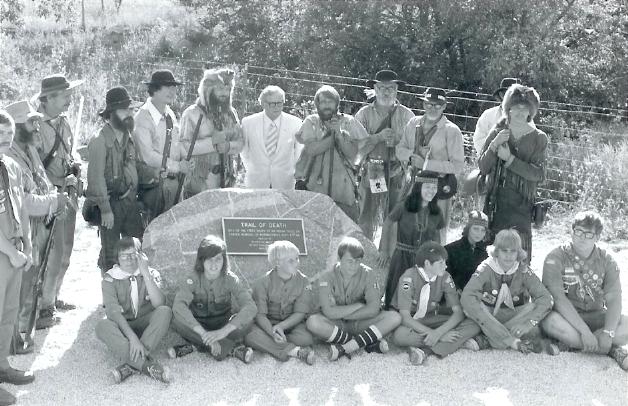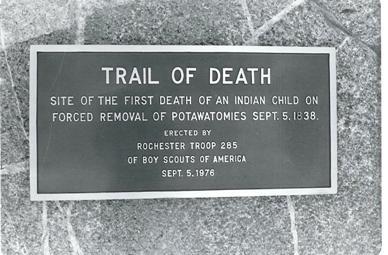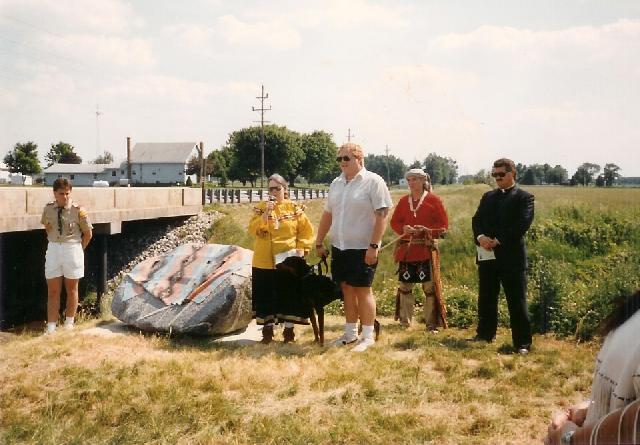Mud Creek
Drive south of Rochester on Indiana 25 for 5 miles to Mud Creek. The Trail of Death marker is on the west side of the highway and north side of the creek. There is room to pull off parallel to the highway on the west side and walk to the marker, which means walking down into the ditch and up again. If it is dry, no problem. If there is standing water, one can best view the marker from the bridge.
Wednesday, 5th Sep, [traveled 9 miles from Chippeway, through Rochester, to Mud Creek on Indiana 25 (Michigan Road) about 6 miles south of Rochester.]
51 persons found to be unable to continue the journey and were left at Chippeway, the most of them sick and the remainder to wait upon them. Proceed on our route. [They marched through Rochester, a line of Indians a mile long. Sympathetic white settlers gave them hoe-cakes to take on trip. A little boy - 6 year old Billy Ward - followed his Indian friends a mile south of Rochester, wanting to go along, but his mother caught him & took him home. This is about where McDonald's fast food restaurant is now.] At half past 12 reached Mud Creek and camped. [The Indiana Magazine of History misinterpreted it as Una Creek in their 1925 issue, but upon looking at the microfilm of the original diary, we saw that it was Mud Creek. Also George Winter the artist called it Mud Creek. Winter sketched the camp site, showing tripods with small kettles for cooking. These were probably transported in the wagons.] The scarcity of water in the country again retarded the progress of the emigration - the distance being either too great or too short between the watering places. A child died on the evening of this day and was buried on the morning of the 7th. [Note: It is unknown if this means the dead baby was carried to Logansport and buried there or if the family stayed behind to bury it at Mud Creek.] A child was born. Party of 3 Indians joined us. Subsistence consisted of beef and flour, and that very difficult to acquire - having in most cases to transport it from Logansport, a distance from the furthest point of 46 miles.

Mud Creek south of Rochester, Indiana. GPS 40.98631 -86.24232.
Buckskinners and Boy Scouts surround Governor Otis Bowen (in white suit in center back row) and the Trail of Death historical marker at Mud Creek during the dedication Sept. 1976. At left is Rick Faught, Scoutmaster. Troop 285 seated on the ground: Shawn Young, Robert Nye, Hank Riffle, Jim Rans, Stuart O'Dell, Chris Henning, and Allen Willard, who earned his Eagle award with this project. To the right of Gov. Bowen is Mike Freese, (no hat) Rochester, the buckskinner who organized the teepee village at the Trail of Death Rendezvous. Behind the Scouts at right are Xena and Kim Carrico, Rochester, in Indian outfits. They had taken part in the re-enactment of the march from the Tippecanoe River through Rochester on Main Street and on to Mud Creek, a distance of 9 miles. (The Rochester Sentinel photo by John Savage.) In his speech Gov. Bowen called it a Trail of Courage so the next year the name of the festival was changed to Trail of Courage Rendezvous. The boulder was donated by McMahan O'Connor Construction Company, Rochester. The Boy Scouts had a chili supper and sold various things (Lemon Air, etc.) to earn money to pay for the metal plaque.

Mud Creek south of Rochester, Indiana. GPS 40.98631 -86.24232.
Dedication in 1991 of the replaced Trail of Death plaque for the first baby to die on the Trail of Death. In the picture the plaque is covered with the same old Indian blanket used for the dedication in 1976, a 1920s blanket that was used for many years by Shirley Willard’s mother, Maye Ogle. The marker is at Mud Creek on Indiana 25 six miles south of Rochester. From left: unidentified Akron scout, Shirley Willard, Allen Willard and his dog Chuck, George Godfrey, Father Frank Kilcline of St. Joseph Catholic Church, Rochester.
Trail of Death marker replaced.
“May the Trail of Death never be forgotten,” prayed Father Frank Kilcline at the dedication of the historical marker June 8, 1991. “Keep us mindful of these events so that we may work to not repeat the bad news of history but may work to improve the lot of all peoples.”
A group of people have not forgotten and they chipped in to replace the Trail of Death historical marker (metal plaque) that was stolen in 1989. The original marker was placed in 1976 by Rochester Boy Scout Troop 285. (The troop no longer existed in 1991.)
Thanks to these people who donated money to buy the plaque: Allen Willard, who earned his Eagle Scout award by placing the marker, Richard and Lova O’Dell and son Stuart, Jacob “Hank” Riffle - former members and parents of Troop 285; Fred Brown, Clem Good, Gloria Fellers, Gates and Velma Thompson, Bob and Carol Bridge, Phyllis Whitmore, Carl and Ruth Davis, all of Fulton County; Ervin Stuntz, Walkerton; Charyl Lawrence, Danville, IL, a member of Society of Indian Lore, the group that placed a Trail of Death historical marker at Danville; and Cynthia Wesley-Esquimaux, a Potawatomi in Ontario, Canada.
Thanks to Alton Perry of Perry’s Custom Lettering for getting the plaque and attaching it to the boulder.
Thank you to Royce Allison, Akron scoutmaster, and his Troop 245 for providing an honor guard for the ceremony: Matt Rager, Kevin Allison, Kalyn Smith, and Adam Swick.
The Citizen Band Potawatomi was represented by George Godfrey, Villa Grove, IL. He read from the Trail of Death diary.
Chief White Eagle, Rochester, performed the pipe ceremony and his wife, Bobbie Bear, did the Lord’s Prayer in Indian sign language.
Shirley Willard, Fulton County Historical Society president, served as master of ceremonies, introducing each person and telling the history of the 1838 forced removal of the Potawatomi Indians from north central Indiana to eastern Kansas. Bill Willard made a video recording.
About 30 persons attended the ceremony. After the ceremony, refreshments were served at the Fulton County Museum by Katie Gropp, Joanna Sheetz, Bill Willard, and Melinda Clinger.
Note: In 2000 the original 1976 plaque was returned to the Fulton County Museum. It was found by a South Bend man in his garage back of a pile of stuff. He had a teenage son (now grown) but did not know how the plaque got there. He gave the stolen plaque to Bob Moody, a Pokagon Potawatomi, and Bob’s mother Marge Moody brought it to FCHS where it is on display.

Mud Creek south of Rochester, Indiana. GPS 40.98631 -86.24232.
Located about 5 miles south of Rochester on west side of Indiana 25 and north side of Mud Creek. (Photo by Allen Willard, Rochester, Indiana, 1977.)
Continue on Indiana 25 to Logansport. The Trail of Death marker is by the hospital, a cement slab with words, set into the hillside on the corner of Indiana 25 (Michigan Ave.) and Fulton Street. This and area to the east to Horney Creek was their camp for 3 days. Because so many Potawatomi were sick, a temporary hospital was set up. Their last Mass in Indiana was there: Bishop Brute & Father Petit came to conduct Mass.
(end of Fulton County)
|